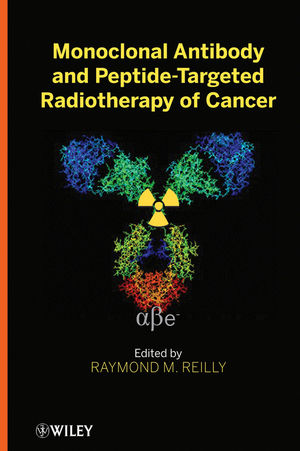Monoclonal Antibody and Peptide-Targeted Radiotherapy of CancerISBN: 978-0-470-24372-5
Hardcover
656 pages
August 2010
 |
||||||
Contributors.
1. Antibody Engineering: Optimizing the Delivery Vehicle (Diane E. Milenic).
1.1 Introduction.
1.2 Intact Murine Monoclonal Antibodies.
1.3 Recombinant Immunoglobulin Molecules.
1.4 Nanobodies.
1.5 Domain-Deleted Monoclonal Antibodies.
1.6 Hypervariable Domain Region Peptides.
1.7 Fv Fragments.
1.8 Minibodies.
1.9 Selective High Affinity Ligands.
1.10 Affibodies.
1.11 Other Strategies.
1.12 Concluding Remarks.
References.
2. The Radiochemistry of Monoclonal Antibodies and Peptides (Raymond M. Reilly).
2.1 Introduction.
2.2 Tumor and Normal Tissue Uptake of Monoclonal Antibodies and Peptides.
2.3 Selection of a Radionuclide for Tumor Imaging.
2.4 Selection of a Radionuclide for Targeted Radiotherapy.
2.5 Labeling Antibodies and Peptides with Radiohalogens.
2.6 Labeling Antibodies and Peptides with Radiometals.
2.7 Characterization of Radiolabeled mAbs and Peptides.
2.8 Summary.
Acknowledgments.
References.
3. The Design of Radiolabeled Peptides for Targeting Malignancies (Leonard G. Luyt).
3.1 Introduction.
3.2 Peptide Targets.
3.3 Peptides as Cancer Targeting Agents.
3.4 Multimodality Agents.
3.5 Future Outlook.
References.
4. Peptide Receptor Radionuclide Therapy in Patients with Somatostatin Receptor-Positive Neuroendocrine Tumors (Martijn van Essen, Dik J. Kwekkeboom, Wouter W. de Herder, Lisa Bodei, Boen L. R. Kam, Marion de Jong, Roelf Valkema, and Eric P. Krenning).
4.1 Introduction.
4.2 Radiotherapy with 111In-Octreotide.
4.3 Radiotherapy with 90Y-DOTATOC.
4.4 Targeted Radiotherapy Studies with 177Lu-Octreotate.
4.5 PRRT with Other Somatostatin Analogues.
4.6 Comparison of Different PRRT Studies.
4.7 Comparison with Chemotherapy.
4.8 Options for Improving PRRT and Future Directions.
4.9 Conclusions.
References.
5. Targeted Radiotherapy of Central Nervous System Malignancies (Michael R. Zalutsky, David A. Reardon, and Darell D. Bigner).
5.1 Malignant Brain Tumors.
5.2 Rationale for Locoregional Therapy.
5.3 Targeted Radiotherapy of Brain Tumors.
5.4 Rationale for Tenascin-C as a Target for Radionuclide Therapy.
5.5 Perspective for the Future.
Acknowledgments.
References.
6. Radioimmunotherapy for B-Cell Non-Hodgkin Lymphoma (Thomas E. Witzig).
6.1 Introduction.
6.2 Radioimmunotherapy.
6.3 Antibodies Against CD22.
6.4 RIT Versus Immunotherapy.
6.5 RIT in Rituximab Refractory Patients.
6.6 RIT for Previously Untreated Patients.
6.7 RIT for Relapsed Large-Cell Lymphoma.
6.8 RIT for Transformed Lymphoma.
6.9 RIT for Mantle Cell Lymphoma.
6.10 Long-Term Results of RIT.
6.11 Risk of Myelodysplasia with RIT.
6.12 Feasibility of Treatment After RIT Failure.
6.13 Combinations of RIT and Chemotherapy.
6.14 High-Dose RIT with Stem Cell Support.
6.15 RIT for Central Nervous System Lymphoma.
6.16 Retreatment with RIT.
6.17 RIT in Children with Relapsed NHL.
6.18 RIT in Patients with Lung Involvement.
6.19 RIT in Patients with Skin Lymphoma.
6.20 RIT in Patients with >25% Marrow Involvement.
6.21 RIT in Older Patients.
6.22 RIT in Hodgkin’s Disease.
6.23 Viral Infections After RIT.
6.24 Radiation Therapy After RIT.
6.25 Summary.
6.26 Future Directions.
References.
7. Radioimmunotherapy of Acute Myeloid Leukemia (Todd L. Rosenblat and Joseph G. Jurcic).
7.1 Introduction.
7.2 Antigenic Targets.
7.3 Radionuclide Selection.
7.4 Radiolabeling.
7.5 Pharmacokinetics and Dosimetry.
7.6 RIT with b-Particle Emitters.
7.7 RIT with a-Particle Emitters.
7.8 Summary.
References.
8. Pretargeted Radioimmunotherapy of Cancer (Robert M. Sharkey and David G. Goldenberg).
8.1 Introduction.
8.2 The Challenge of Improving Tumor/Nontumor Ratios.
8.3 Pretargeting: Uncoupling the Antibody–Radionuclide Conjugate.
8.4 Clinical Studies of Pretargeting.
8.5 Prospects for Combination Therapies.
8.6 Future Innovations.
8.7 Conclusions.
References.
9. Targeted Auger Electron Radiotherapy of Malignancies (Raymond M. Reilly and Amin Kassis).
9.1 Introduction.
9.2 Radiobiological Effects of Auger Electrons.
9.3 Selection of an Auger Electron-Emitting Radionuclide.
9.4 Microdosimetry.
9.5 Molecular Targets for Auger Electron Radiotherapy of Cancer.
9.6 Small-Molecule Auger Electron Radiotherapy.
9.7 Summary and Conclusions.
Acknowledgments.
References.
10. Viral Introduction of Receptors for Targeted Radiotherapy (Kathryn Ottolino-Perry and Judith Andrea McCart).
10.1 Introduction.
10.2 Viral Vectors.
10.3 Virally Delivered Receptors.
10.4 Combined Oncolytic and Targeted Radiotherapy.
10.5 Summary.
References.
11. Preclinical Cell and Tumor Models for Evaluating Radiopharmaceuticals in Oncology (Ann F. Chambers, Eva A. Turley, John Lewis, and Leonard G. Luyt).
11.1 Introduction.
11.2 Traditional Approaches to Preclinical Evaluation of Radiotherapeutics.
11.3 Models of Cancer.
11.4 Animal Models for Evaluating Radiopharmaceuticals: Unresolved Issues and Challenges for Translation.
References.
12. Radiation Biology of Targeted Radiotherapy (David Murray and Michael Weinfeld).
12.1 Introduction.
12.2 Targeted Radionuclide Therapy: Concepts.
12.3 Radiation-Induced DNA Damage.
12.4 Cellular DNA Damage Surveillance–Response Networks.
12.5 Mammalian DNA-Repair Pathways.
12.6 Modes of Cell Death Following Radiation Exposure.
12.7 Conventional Models for Cell Survival Curves, Fractionation, and Dose-Rate Effects.
12.8 Low-Dose Hyperradiosensitivity-Increased Radioresistance.
12.9 Inverse Dose-Rate Effects.
12.10 Cross fire.
12.11 The Radiobiological Bystander Effect.
12.12 The Adaptive Response.
12.13 A Possible Contribution from Low-Dose Radiobiological Mechanisms to TRT Tumor.
Responses?.
12.14 Use of Radionuclides Other Than b-Particle Emitters.
12.15 Role of Tumor Hypoxia and Fractionation Effects.
12.16 Summary and Future Directions.
Acknowledgments.
References.
13. Dosimetry for Targeted Radiotherapy (Sui Shen and John B. Fiveash).
13.1 Introduction.
13.2 Basic Concepts of MIRD Dosimetry.
13.3 Preclinical Dosimetry.
13.4 Clinical Dosimetry Methods.
13.5 Dosimetry for Dose-Limiting Organs and Tumors.
13.6 Conclusions.
References.
14. The Bystander Effect in Targeted Radiotherapy (Carmel Mothersill and Colin Seymour).
14.1 Introduction.
14.2 Historical Review of Bystander Effects in the Context of Radiation Damage to Cells.
14.3 New Knowledge and the Pillars of the Developing New Paradigm.
14.4 Concept of Hierarchical Levels of Assessment of Targeted Radiation Effects.
14.5 The New Meaning of the LNT Model.
14.6 Techniques for Studying Bystander Effects.
14.7 Bystander Phenomena in Targeted and Conventional Radiotherapy.
14.8. Mechanisms Underlying Bystander Effects and Detection Techniques.
14.9. The Future.
References.
15. The Role of Molecular Imaging in Evaluating Tumor Response to Targeted Radiotherapy (Norbert Avril).
15.1 Introduction.
15.2 Positron Emission Tomography.
15.3 Response to Cancer Treatment Including Targeted Radiotherapy.
References.
16. The Economic Attractiveness of Targeted Radiotherapy: Value for Money? (Jeffrey S. Hoch).
16.1 Introduction.
16.2 Applying Economics in Theory.
16.3 Applying Economics in Practice.
16.4 The Economic Attractiveness of Targeted Radiotherapy: the Case of 90Y-Ibritumomab Tiuxetan (Zevalin).
16.5 Conclusions.
References.
17. Selected Regulatory Elements in the Development of Protein and Peptide Targeted Radiotherapeutic Agents (Thomas R. Sykes and Connie J. Sykes).
17.1 Introduction.
17.2 Administrative and Organizational Elements.
17.3 Pharmaceutical Quality Elements.
17.4 Nonclinical Study Elements.
17.5 Clinical Study Elements.
17.6 Summary.
Dedication.
References.
Index.



